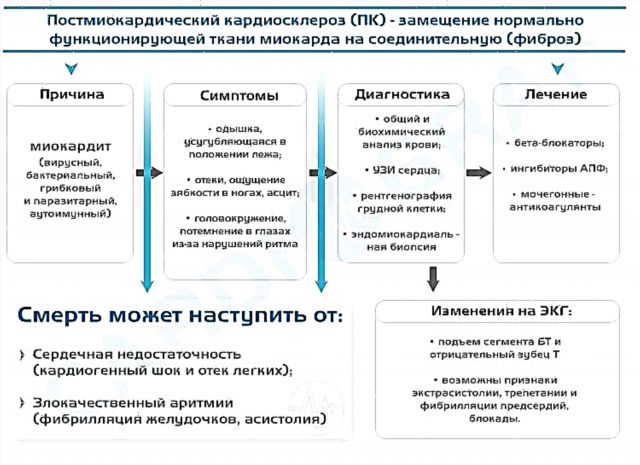The incidence of colds or ARIs is very high in the fall-spring period. The first manifestations include a runny nose, sore throat, weakness, and hyperthermia. Many do not pay attention to this, not taking seriously the whole danger, and endure the disease "on their feet." But, noticing pain in the heart after a temperature, they begin to worry about their state of health, which is absolutely rational, because sometimes the consequences of mild respiratory infections have a heavy effect on the performance of the heart.
The effect of increasing temperature on the cardiovascular system
Almost all viral and bacterial infections occur with severe intoxication syndrome, which includes high body temperature, weakness, headache, and dizziness. The cardiovascular system immediately reacts to heat - the heart rate increases (in adults by 8-10 beats / min, in children - 10-15 beats / min per degree), peripheral vessels expand, as a result of which the skin turns red and gets warmer to the touch. This is necessary to control thermoregulation: to increase heat transfer through the skin. The combination of temperature and high heart rate is the body's defense mechanism.
Why are there pains in the heart?
With an increase in temperature and intoxication, human organs and systems work in an enhanced mode to ensure vital functions. The heart reacts especially strongly to changes in homeostasis. These processes significantly increase the load on the myocardium:
- viral or bacterial intoxication - increases the heart rate (heart pain with angina - read here);
- hyperthermia, which changes the rheology of the blood (increases the viscosity and density);
- change in vascular tone with temperature jumps;
- metabolic imbalance against the background of changes in the physical parameters of the internal environment (T, pressure, pulse).
All of the above factors are the causes of heart pain during fever, since the load on the organ increases, which cannot receive enough nutrition and oxygen, while in a state of ischemia.
It happens that colds occur without hyperthermia, and sometimes even with a low temperature (up to 35 degrees), but with the rest of the typical symptoms: a runny nose, headache, cough or sore throat. A dangerous sign is the appearance of tachycardia with a cold without fever, because such a phenomenon speaks of heart weakness, myocardial ischemia or infectious pathologies that cause it.
How to diagnose
When pain in the heart appears after a high fever or during a cold, they immediately consult a doctor, because this is both a sign of intoxication, and the first signal of dangerous diseases: myocarditis, pericarditis, rheumatic fever.
First of all, the doctor will conduct a thorough collection of anamnesis of the disease, examine, prescribe examinations: general blood and urine analysis, biochemical profile (total protein and its fractions, AST, CPK, creatinine, urea), electrocardiogram. If necessary, supplement the diagnosis with echocardiography, analysis for the detection of antibodies to streptococcus, chest x-ray.
Differential diagnosis:
- Acute rheumatic fever - a systemic disease with a predominant lesion of the cardiovascular system caused by group A β-hemolytic streptococcus:
- previously transferred angina;
- increased body temperature, pain in the region of the heart, tachycardia, weakness;
- possible appearance of arthralgia, chorea;
- auscultatory - pathological noise;
- laboratory diagnostics - an increase in ESR, leukocytosis, an increased level of C-reactive protein, increased titers of antistreptolysin-O;
- ECG - rhythm and conduction disturbances, lengthening of the P-Q interval;
- on ECHO-KG - pathology of the heart valves.
- Myocarditis - inflammation of the muscular membrane of a viral, bacterial or fungal nature. There are also variants of the disease without a pathogen: autoimmune, aseptic and toxic. The leading symptoms in these cases are intoxication, fever, weakness and shortness of breath, pain in the heart of an aching and burning character. The condition requires inpatient treatment and long-term outpatient follow-up:
- complaints of shortness of breath, pain in the region of the heart, not related to exertion;
- auscultation - weakening of tones, arrhythmia, a decrease in the strength of the pulsation in the apex of the heart;
- laboratory changes - an increase in LDH, CPK, AST, increased ESR, C-reactive protein, leukocytosis;
- on the ECG - rhythm disturbances in the form of tachycardia, extrasystole, atrial fibrillation, changes in the T wave;
- cardiomegaly on x-ray.
- Pericarditis - an inflammatory process of the pericardium, which is often associated with the accumulation of fluid in its cavity. Pathology is characterized by several signs that help to clearly suspect and diagnose it. These include pain in the lower sternum, the intensity of which changes with a change in body position; "crunching" noise during auscultation of the heart; a typical pose of the patient - "praying Bedouin":
- provoked by viral and bacterial infections;
- complaints of weakness, dull pain behind the sternum, which radiates to the arms and intensifies in the supine position;
- laboratory diagnostics - nonspecific changes characteristic of inflammatory diseases;
- X-ray - enlarged shadow of the heart, disappearance of the waist.
4. Endocarditis - inflammation of the inner lining (rare situation). It is more common among injection drug users due to constant infection of the intravascular space. The disease causes severe intoxication, high temperature readings, serious hemodynamic disturbances. The treatment plan includes antibiotics of the reserve group.
Conclusions
A viral or bacterial disease, which is accompanied by symptoms of intoxication, requires treatment and adherence to all the doctor's recommendations, including a gentle mode of activity. Against the background of an elevated temperature, disturbances in the functioning of the heart appear, associated with damage to its muscular and conducting systems. Timely diagnosis and treatment of colds prevents complications from the cardiovascular system. If you have been diagnosed with ARVI and after that there was discomfort in the chest, read our article on the topic "Pain in the heart with ARVI".



